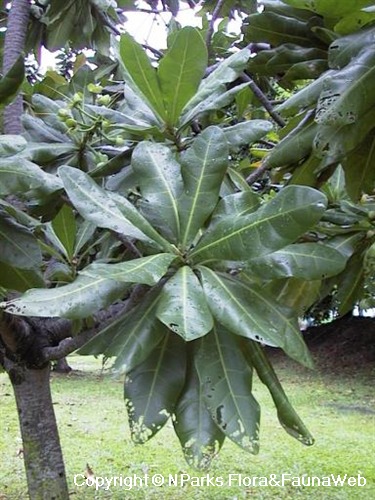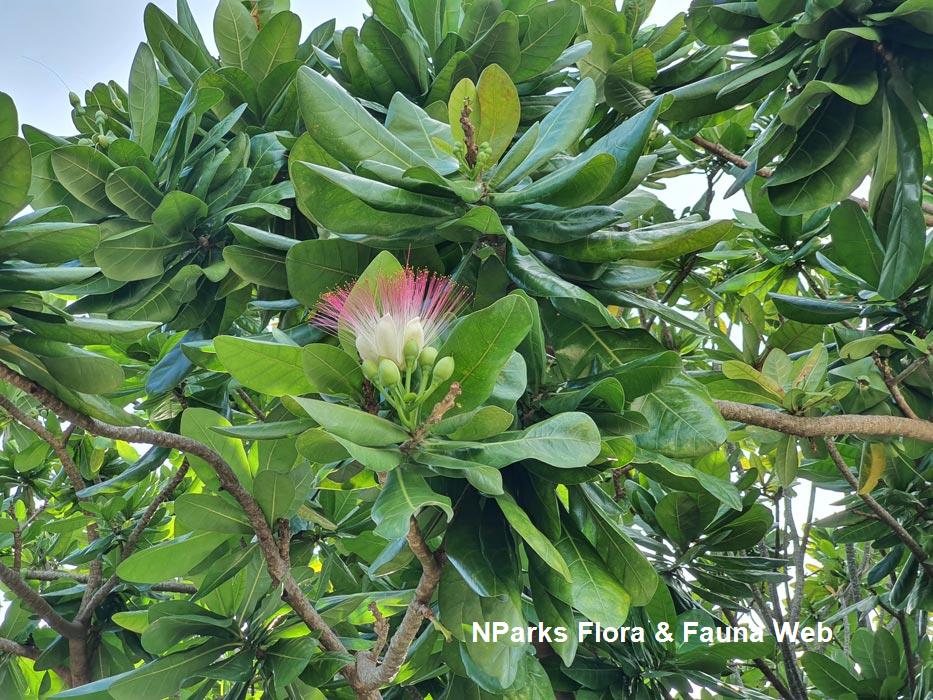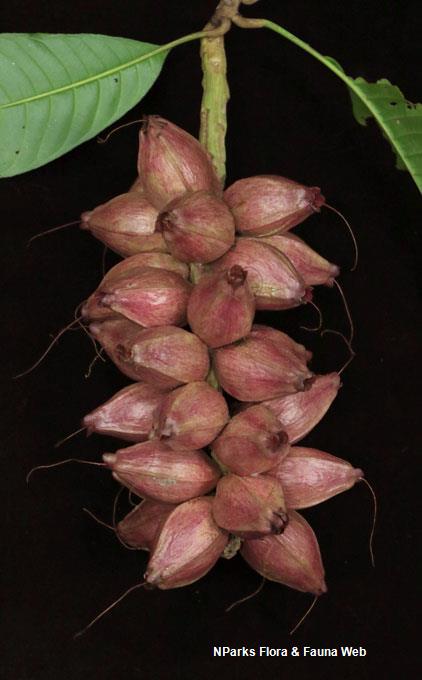_lowres.jpg)
Back
Barringtonia asiatica (L.) Kurtz
| Family Name: | Lecythidaceae |
| Synonyms: | Barringtonia speciosa J.R.Forst. & G.Forst. |
| Common Name: | Putat Laut, Fish Poison Tree, Fish-killer Tree, Beach Barringtonia, Putat Gajah, Mindilla, Sea Putat, Barringtonia, Butun, Butong, Pertun, 棋盘脚树, 滨玉蕊 |
Barringtonia asiatica, also known as Putat Laut, has showy flowers with numerous filamentous stamens that are white with pink tips. The fruits and seeds are crushed and used as fish poisons as they contain toxic saponins.
Name
Classifications and Characteristics
| Plant Division | Angiosperms (Flowering Seed Plants) (Dicotyledon) |
|---|---|
| Plant Growth Form | Tree (Medium (16m-30m)) |
| Lifespan (in Singapore) | Perennial |
| Mode of Nutrition | Autotrophic |
| Plant Shape | Rounded |
| Maximum Height | 15 m to 30 m |
Biogeography
| Native Distribution | Tropical Africa, Madagascar, India, Thailand, Cambodia, Vietnam, Taiwan, Malesia, northern Australia, and Pacific Islands |
|---|---|
| Native Habitat | Terrestrial (Coastal Forest) |
| Preferred Climate Zone | Tropical |
| Local Conservation Status | Native to Singapore (Critically Endangered (CR)) |
Description and Ethnobotany
| Growth Form | It is a tree up to 30 m tall, with a round crown of shiny, large, dark green leaves. |
|---|---|
| Trunk | The unbuttressed trunk has pinkish-grey bark. |
| Foliage | Its spirally arranged, stalkless leaves possess leathery leaf blades that are shiny dark green, drop-shaped, and 15–52 by 7–21 cm. Its fresh leaves are pinkish-olive with distinct pink veins, and wither yellow to pale orange. |
| Flowers | Its flowering stalk is 2 - 20 cm long,, found at the ends of the branches and more or less upright, unlike the hanging ones typical of other Barringtonia species. Each stalk contains 3 - 20 flowers. Its stalked flowers are bisexual, 15-cm wide, and appear fluffy because of the presence of numerous, white, pink-tipped stamens. Its strongly fragrant flowers also open around sunset in ones or two, in readiness for the nocturnal animal pollinators. |
| Fruit | Its 1–2-seeded fruits are 7–10 cm wide, with a broad square base tapering to two rounded sepals. The fruits mature from green to brown. They hang from branches, and have a tough, corky-fibrous husk that aids in their dispersal by water. Its seeds are oblong, and 4–5 cm long. |
| Habitat | It grows along sandy coasts and seashores. It occurs locally in Labrador Park. |
| Associated Fauna | It is the food plant for moth larvae of Dasychira spp. and Thyas honesta. Fruit bats and night-flying moths are attracted to its flowers and act as pollinators. |
| Cultivation | It can be propagated by seed. |
| Etymology | Latin Barringtonia, after Hon. Daines Barrington (1727–1800), English naturalist; Latin asiatica, asian; referring to the natural distribution of the plant. |
| Ethnobotanical Uses | Timber & Products: The wood is used to construct boats and huts. Cultural / Religious: Heritage Tree: There is currently one individual of Barringtonia asiatica listed as Heritage Tree in Singapore. It can be found at Singapore Botanic Gardens. To find out more about this tree, please visit the Heritage Tree Register. Others: Oil extracts from the seeds are used as an illuminant. The fruits and seeds are used as fish poisons as they contain toxic saponins. |
Landscaping Features
| Desirable Plant Features | Ornamental Flowers, Ornamental Foliage, Fragrant (Flowers) (Night, Dawn / Dusk, Day) |
|---|---|
| Landscape Uses | Coastal, Parks & Gardens, Shade Providing Tree / Palm |
| Thematic Landscaping | Economic Garden, Naturalistic Garden |
| Usage Hazard - Cons Remarks | Fruits may cause injury or damage when they drop. Do not plant tree at car parks and areas with pedestrain traffic. |
Fauna, Pollination and Dispersal
| Pollination Method(s) | Biotic (Fauna) (Insects (Butterfly, Moth), Vertebrates (Bat)) |
|---|---|
| Seed or Spore Dispersal | Abiotic (Water) |
Plant Care and Propagation
| Light Preference | Full Sun |
|---|---|
| Water Preference | Moderate Water |
| Plant Growth Rate | Moderate |
| Rootzone Tolerance | Waterlogged Soils (Drains Site), Saline Soils / Salt Spray |
| Maintenance Requirements | Moderate |
| Propagation Method | Seed, Stem Cutting |
Foliar
| Foliage Retention | Evergreen |
|---|---|
| Mature Foliage Colour(s) | Green |
| Mature Foliage Texture(s) | Smooth, Glossy / Shiny, Leathery, Thick |
| Prominent Young Flush Colour(s) | Pink |
| Foliar Type | Simple / Unifoliate |
| Foliar Arrangement Along Stem | Rosulate / Rosette |
| Foliar Shape(s) | Non-Palm Foliage (Obovate) |
| Foliar Venation | Pinnate / Net |
| Foliar Margin | Entire |
| Foliar Apex - Tip | Acute, Obtuse |
| Typical Foliar Area | Mesophyll ( 45cm2 - 182.25 cm2 ) |
| Leaf Area Index (LAI) for Green Plot Ratio | 3.0 (Tree - Intermediate Canopy) |
Non - Foliar and Storage
| Trunk Type (Non Palm) | Woody |
|---|---|
| Bark Colour(s) | Pinkish grey |
| Mature Bark Texture | Smooth |
| Stem Type & Modification | Woody |
| Root Type | Underground (Tap Root, Fibrous Root) |
Floral (Angiosperm)
| Flower & Plant Sexuality | Bisexual Flowers |
| Flower Colour(s) | Pink, White |
|---|---|
| Flower Size - Remarks | 15cm across |
| Flowering Opening Time | Night (dusk to dawn) |
| Flower Lifespan on Plant | 1 Night |
| Flowering Habit | Polycarpic |
Fruit, Seed and Spore
| Mature Fruit Colour(s) | Brown |
|---|---|
| Fruit Classification | Simple Fruit |
Image Repository
Others
| Master ID | 1451 |
|---|---|
| Species ID | 2744 |
| Flora Disclaimer | The information in this website has been compiled from reliable sources, such as reference works on medicinal plants. It is not a substitute for medical advice or treatment and NParks does not purport to provide any medical advice. Readers should always consult his/her physician before using or consuming a plant for medicinal purposes. |

_lowres.jpg)


_lowres.jpg)





_lowres.jpg)



_lowres.jpg)
